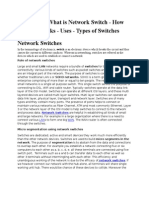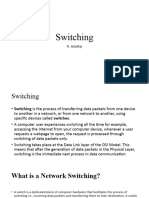0% found this document useful (0 votes)
5 views4 pagesSwitch
A network switch is a device that connects multiple devices within a LAN, intelligently forwarding data using MAC addresses. It operates primarily at the data link layer and can perform functions like packet forwarding, MAC address learning, and VLAN support. There are various types of switches, including managed switches, Layer 3 switches, and PoE switches, each serving different networking needs.
Uploaded by
Anushka PandeyCopyright
© © All Rights Reserved
We take content rights seriously. If you suspect this is your content, claim it here.
Available Formats
Download as PDF, TXT or read online on Scribd
0% found this document useful (0 votes)
5 views4 pagesSwitch
A network switch is a device that connects multiple devices within a LAN, intelligently forwarding data using MAC addresses. It operates primarily at the data link layer and can perform functions like packet forwarding, MAC address learning, and VLAN support. There are various types of switches, including managed switches, Layer 3 switches, and PoE switches, each serving different networking needs.
Uploaded by
Anushka PandeyCopyright
© © All Rights Reserved
We take content rights seriously. If you suspect this is your content, claim it here.
Available Formats
Download as PDF, TXT or read online on Scribd
/ 4
































































